R-16: Difference between revisions
Pbcjohnston (talk | contribs) Added captions |
Pbcjohnston (talk | contribs) mNo edit summary |
||
| Line 37: | Line 37: | ||
</div> | </div> | ||
<div style="text-align: justify;"><span style="color:#00008B">A large number of interior photos of the R-16 were discovered at the Vallejo Naval & Historical Museum by submarine researcher Darryl Baker. He kindly took the time to scan the images and send them on to PigBoats.COM for posting. We have worked at bringing out as much detail of the images as possible and in a number occasions even make close-ups of interesting bits of information. The photos are reported to have been taken in 1923. | <div style="text-align: justify;"><span style="color:#00008B">A large number of interior photos of the R-16 were discovered at the Vallejo Naval & Historical Museum in California by submarine researcher Darryl Baker. He kindly took the time to scan the images and send them on to PigBoats.COM for posting. We have worked at bringing out as much detail of the images as possible and in a number occasions even make close-ups of interesting bits of information. The photos are reported to have been taken in 1923. | ||
[[File:Red bar sub new.jpg]] | [[File:Red bar sub new.jpg]] | ||
Revision as of 21:13, 24 September 2023
Exterior and Crew Photos
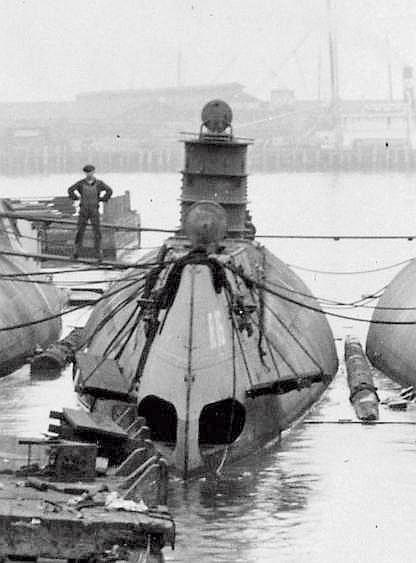
Photo courtesy of the Submarine Force Library & Museum.
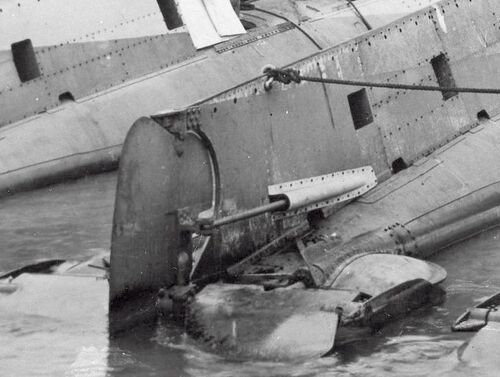
Photo courtesy of the Submarine Force Library & Museum.
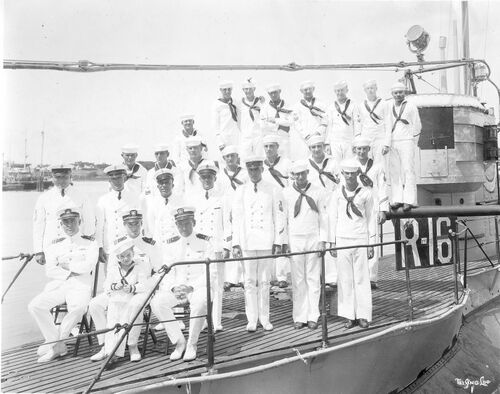
U.S. Navy photo.

Photo courtesy of the USSVWII via Navsource.org
Interior Photos
Notes
Torpedo Room
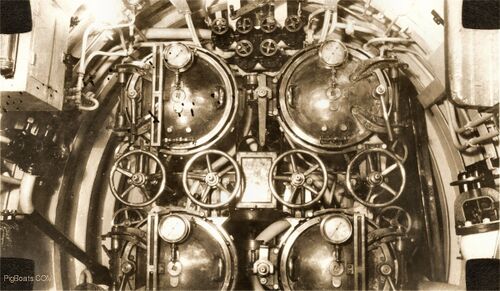
Each door has a sea pressure gauge and sight glass except for door on Number One torpedo tube. The sight glass may have been damaged and has yet to be replaced. The tubes are numbered from right to left and top to bottom; 1, 2 and 3, 4. Odd numbers on the starboard side and even on the port side. The row of large wheel handles are for opening and closing the shutter doors on the outside of the bow. The shutters are inter-linked with the torpedo tube muzzle door that close off the seaward end of the torpedo tube.
The black squares in the corners are from the tabs that glued the photo into the original scrapbook.
Photo in the collection of the Vallejo Naval & Historical Museum. Contributed by Darryl Baker
Forward Battery Compartment/Berthing

The forward battery compartment housed both enlisted crew as well as the sub's three officers. The starboard side, seen here, is for bunks and lockers for enlisted. The port side, blocked off by a canvas curtain is where the officers had their quarters. On the right edge of the photo can be seen the end of a table with cloth over it. This table acted as a desk and eating surface for the officers.
Under the deck was one half of the boat's massive storage battery. It contained 60 cells. The battery well was covered by wood planking and bolted down and then heavy canvas was shellacked down over the planks to make it watertight. Shellac gave the decks their dark green color.
Photo in the collection of the Vallejo Naval & Historical Museum. Contributed by Darryl Baker
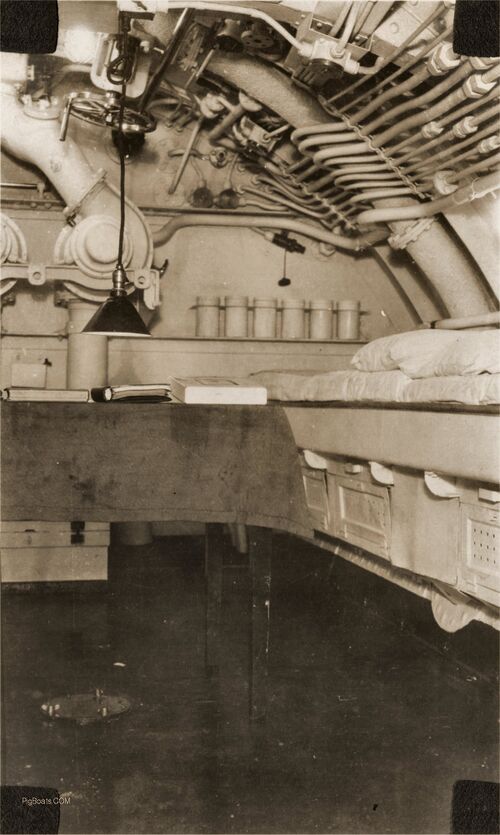
Two of the officer's bunks are seen on the right of the photo. There are storage lockers under the bunks. Not seen are larger cupboards and lockers for officer's use. The purpose of the six canisters against the bulkhead are unknown. They could hold soda lime to absorb CO2 in an emergency, although the containers seem a bit small for that purpose. Battery well ventilation blowers are seen against the bulkhead along with piping to the battery well. This system was used to exhaust battery gases during charging to prevent explosions.
The dark shaft seen to the left of top center, next to the valve handle, is the drive shaft for operating the bow planes.
Photo in the collection of the Vallejo Naval & Historical Museum. Contributed by Darryl Baker
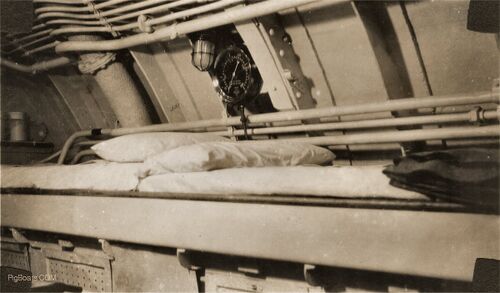
Photo in the collection of the Vallejo Naval & Historical Museum. Contributed by Darryl Baker

Photo in the collection of the Vallejo Naval & Historical Museum. Contributed by Darryl Baker
Control Room

The surrounding gauges seems to be for monitoring the various air pressure systems; 60 psi., 100 psi., 200 psi., & 300 psi. Hinted at but no photo taken, at the left top is another gauge which is possibly part of a series of gauges for the different air banks.
Photo in the collection of the Vallejo Naval & Historical Museum. Contributed by Darryl Baker
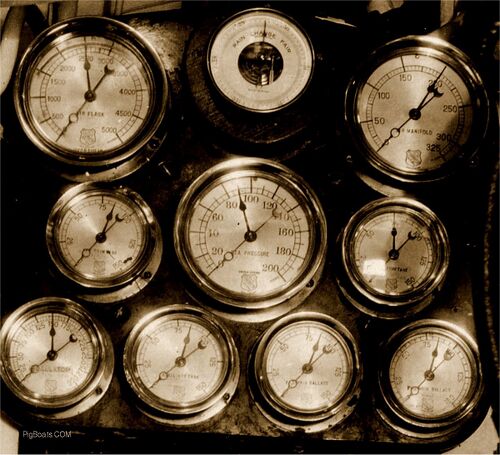
The center row, left to right the dials say: "Aft Trim Tank"; Sea Pressure" and "Fwd Trim Tank".
The bottom row of dials say; "Regulator"; "Auxiliary Tank"; "Aft Main Ballast", and "Fwd Main Ballast".
Photo in the collection of the Vallejo Naval & Historical Museum. Contributed by Darryl Baker
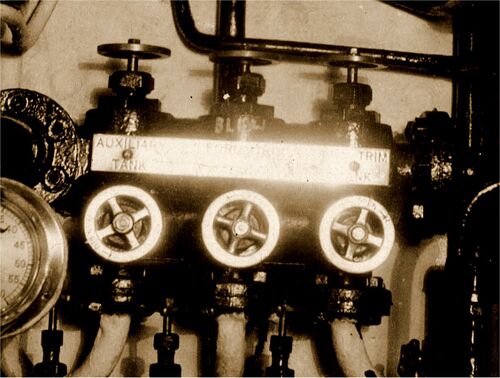
Photo in the collection of the Vallejo Naval & Historical Museum. Contributed by Darryl Baker

The depth gauges only show 100 feet though the submarines had a test depth of 200 feet. Many skippers complained about having no way of knowing how deep they were after the first 100 feet. Finally the Navy relented and made deeper gauges available.
Above the stern planes wheel is a speaking tube, though where it came from or went isn't known at this time.
Photo in the collection of the Vallejo Naval & Historical Museum. Contributed by Darryl Baker
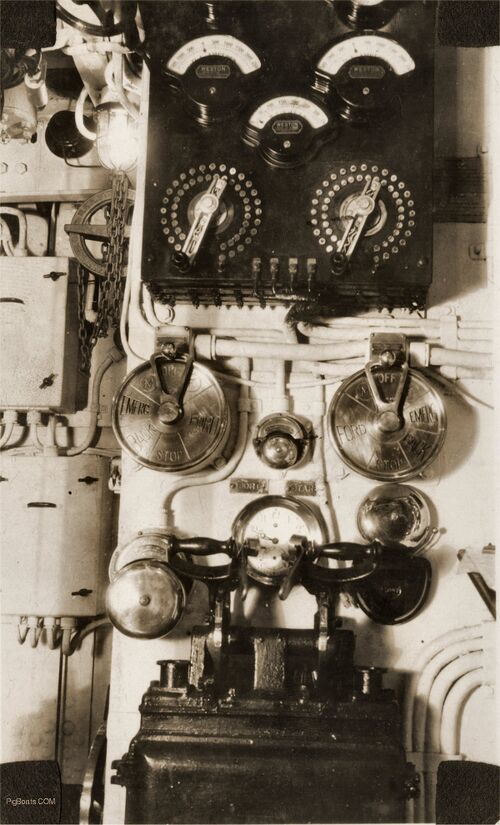
This arrangement sits on the forward side of the bulkhead that enclosed the radio room. The view is looking aft. Between the engine order telegraphs is a bell and on either side of that are small signs that say "PORT" and "STAR". Since the operator is facing aft the controls would be backwards so board is set up as if the operator was facing the other direction. This whole arrangement was moved aft of the engine room in later submarine classes and eventually became what is known as the maneuvering room.
Photo in the collection of the Vallejo Naval & Historical Museum. Contributed by Darryl Baker
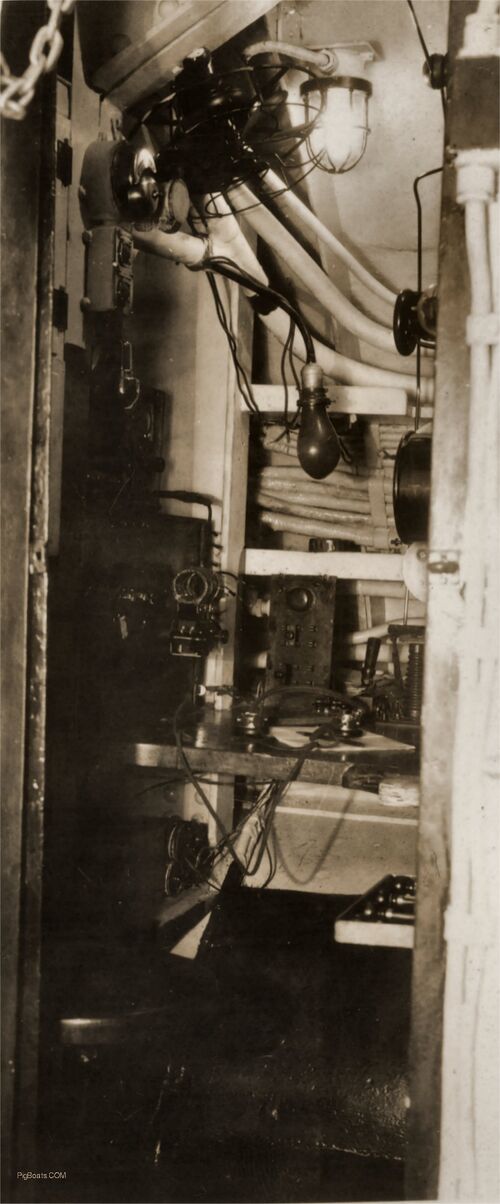
Photo in the collection of the Vallejo Naval & Historical Museum. Contributed by Darryl Baker
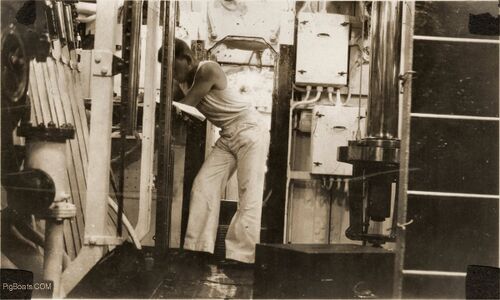
The two large boxes on the bulkhead can also be seen in the photo showing the Motor Controllers. The man standing at a small desk is Radio Electricians Mate 3rd Class E. R. Brown and would have worked in the radio room. He would have also needed to know how to send Morse Code via blinker light and send and read semaphore using hand flags, combining the jobs of Radioman and Signalman into one job on a submarine. The R-16 was stationed at Pearl Harbor for 11 years. These subs had no air conditioning and were hot below decks, hence the reason for the casual dress seen in this photo.
To the left in the photo are seen the levers for operating the Kingston valves that are used for diving or surfacing.
Photo in the collection of the Vallejo Naval & Historical Museum. Contributed by Darryl Baker
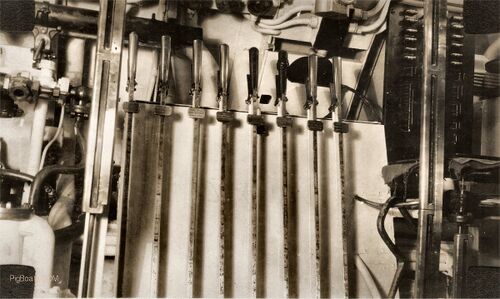
The large sight gauges seen to the right and left of the Kingston levers are, on the right, for the Auxiliary Tanks (there were two of these) and the one on the left is for the Regulator Tank. (This tank is to change its name in the future and become the Negative Tank. All were used to adjust Trim and Weight.)
The large tube in the upper left corner and extending over the top of the first three levers is the barrel cooling tube for the Lewis Mk VI Light Machine Gun that would be mounted on the bridge if needed.
Photo in the collection of the Vallejo Naval & Historical Museum. Contributed by Darryl Baker
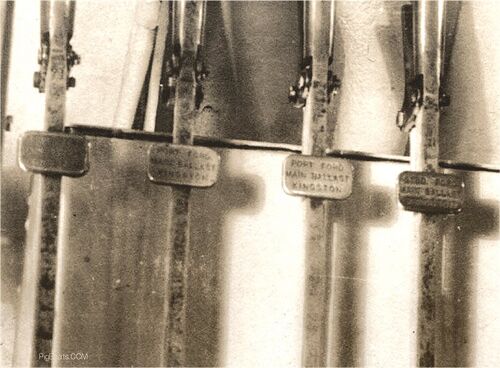
Photo in the collection of the Vallejo Naval & Historical Museum. Contributed by Darryl Baker

The Regulator Tank handle looks to have some sort of coating to make it feel different. The Auxiliary Tank Kingston handle has been wrapped and then a Turks Head Knot applied to it so it feels different from all the rest. It is also painted. This was an attempt to make it easier to operate the levers correctly in the dark.
Photo in the collection of the Vallejo Naval & Historical Museum. Contributed by Darryl Baker
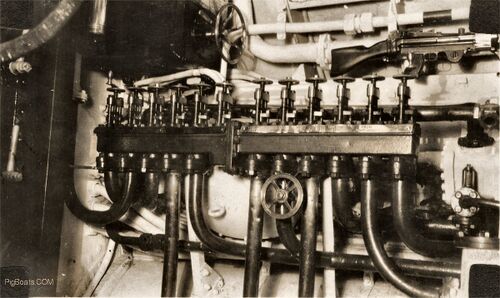
Only a few names can be read on the right side name plate. The far left says "From Bilge". The next two are unreadable. The fourth reads "Trim Line Aft". The fifth reads "From Duct Keel". The last is unreadable. The large back box with the big wheel is the regulator for the trim pump, used for moving the ballast water between the various tanks.
In the upper right corner of the photo the rest of the Lewis Mk VI .30-06 light machine gun can be seen. There were mounts on the bridge where this could be placed if it was needed for protection.
Photo in the collection of the Vallejo Naval & Historical Museum. Contributed by Darryl Baker

Lewis and family settled in England where he became extremely rich from license agreements for his gun. The English and Empire troops used it with much success all through WW I and WW II. After WWI, the U.S. military adopted it in numbers, although it was never as popular as the .30 caliber Browning Machine Gun. There were two calibers for this gun, the British .303 and the American .30-06. The gun used a distinctive 47 or 97 round circular pan magazine mounted on the top of the weapon. It also had extensive cooling fins attached to the barrel, covered by a tube that made the barrel look a lot larger than it really was. Lewis Guns were used by many nations up through the mid 1950's.
If you look closely at the movie "Star Wars: A New Hope" there is a scene in which filmmaker George Lucas adapted a Lewis gun as a Stormtrooper weapon!
Photo in the collection of the Vallejo Naval & Historical Museum. Contributed by Darryl Baker
After Battery Compartment/Crew's Mess



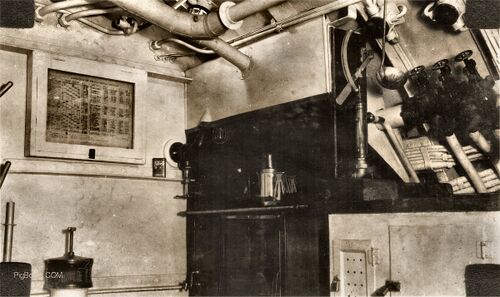


Engine Room

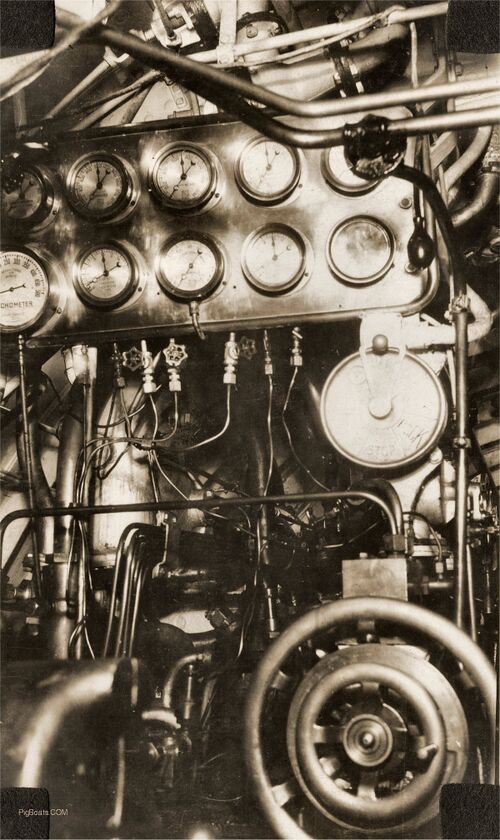

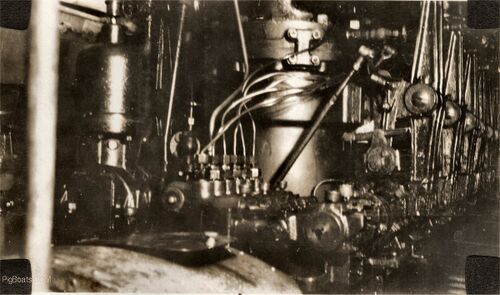
Motor Room

Page created by:
Ric Hedman & David Johnston
1999 - 2023 - PigBoats.COM©
Mountlake Terrace, WA, Norfolk, VA
webmaster at pigboats dot com
